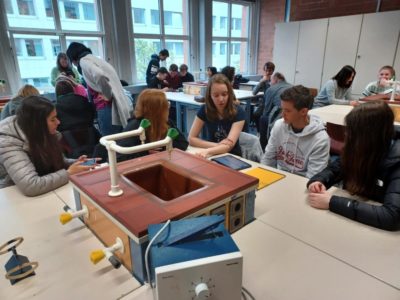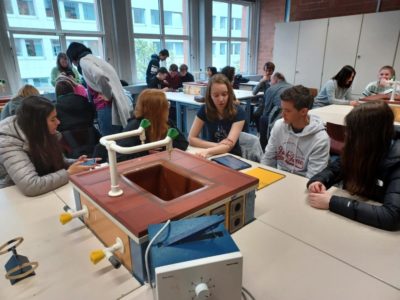In the week of April when Earth Day is celebrated a group of students from the DCG took part in the student exchange taking place in Mallinckrodt Gymnasium in Dortmund, Germany from 18th to 22nd April 2023. This is how the participants themselves experienced this exciting event.
»On Tuesday morning we set off for Frankfurt, then continued to Dortmund by Germany’s fastest train. We arrived in Dortmund at around 6 pm, where we were met by our host families. We spent the evening in the warm embrace of their homes. On Wednesday morning we officially started our exchange at our partner school Mallinckrodt Gymnasium. The name of the project is Futur€nvironment, so our programme included topics and activities to raise awareness of environmental issues. We discussed pollution, global warming, carbon footprint and sustainable lifestyles. In the project were involved students from six countries; Germany, France, Belgium, Scotland, Macedonia and Slovenia. First, we started with various icebreaking activities so we could get to know all the participants. We continued with a tour of the school. The Catholic school is located in the city centre and has more than 1000 students. It was named after Pauline von Mallinckrodt, a nun who played an important role in women’s education at the end of the 19th century.
In the morning, we took part in workshops. After lunch we went on a “selfie tour” of the city. In mixed groups, we discovered hidden corners of the city that contribute in their own way to sustainable development and a better quality of life. Dortmund is a relatively new city, having been destroyed by bomb attacks during WW II. It is one of Europe’s greenest cities, with many parks, tree plantations and gardens. Infrastructure is also modern, with the exception of a few old industrial buildings. /Iza and Eva, year 3/
On Thursday, we woke up to a slightly rainy morning, but that didn’t dampen our spirits, as we knew we had to make the most of every day. We gathered at school at 8 o’clock and headed to the atrium, where we were briefed on the day’s schedule. We had various workshops available, and some of us (Eva, Iza, and Jurij) continued with the Water Heroes workshop from Wednesday. Our relationship with water was examined and what we can do to keep it clean, while others participated in the Future of Energy workshop, and the rest in Let’s be Sustainable workshop. In the Future of Energy workshop, Zarja and Ajda, along with other participants, discussed the problems of using non-renewable sources of energy and their impact on the environment. They thought about alternative energy sources and the challenges we face in transitioning to greener energy sources. They wrote a letter to the European Union Commission to make them aware that young people care about the world they will live in. In the Let’s be Sustainable workshop, Anja, Ema, and Neža, along with others, first learned about what we can do ourselves for a better future, and then they recorded a DIY video showing their newly acquired knowledge, teaching us how to make our own waste bags from newspaper. Then came our favourite part of the day, snack time, followed by the second round of workshops. We had three different workshops available: Urban Future, DIY Shower Gel and Soap, and Design Your Own Jute Bag. At the Urban Future workshop, attended by Ema and Jurij, we saw how our cities could look in the future, and then the participants themselves designed and made their own “houses of the future,” which were then put on display. At the DIY Shower Gel and Soap workshop, Zarja, Anja, and Ajda learned something new about microplastics, which are found almost everywhere, even in shampoos and water. Then they made their own environmentally friendly shower gel. The last of the workshops was Design Your Own Jute Bag, where Eva, Iza, and Neža learned about the advantages of using sustainable bags and decorated their own reusable bag. We then had a brief summary of all the activities we had done, and then we headed to our hosts. /Jurij and Zarja, year 2/
On Friday morning, we took a bus to the Gasometer in Oberhausen, where we saw the fragile paradise exhibition. The exhibition was on three floors, and viewing the city and its surroundings from the roof was possible. The exhibition was held in a building in a form of a silo, which was intended for the storage of gases. It was written on the exhibition flyer that “The aim of the exhibition is to show the beauty of our planet, which is worth protecting, but it also means to draw attention to the abuses that threaten our paradise.” On the first floor there were various pictures of our planet, its biodiversity, and natural and cultural features. On the second floor there were pictures of our planet destroyed by global warming along with activities that pollute the environment presented in the form of pictures. However, measures and goals to prevent further warming were also displayed. On the 100 m high third floor there was a 20 m large model of the earth on which various videos were projected. We were able to observe the paths of planes and ships, the illumination of the earth at night due to cities, the formation of continents, the melting and formation of ice in the wider area of Antarctica and the Arctic and much more. The entire city of Essen and its surroundings could be seen from the top of the building.
Afterwards, we had lunch and then attended the closing ceremony. It started with watching the videos made at the various workshops in which we participated. All the products that were made were put on display. We looked at the products of different workshops then took each of our products and stored them. Having finished with this, we sat back and there was a presentation of all the people who participated, from students to teachers and hosts. Here we also received a certificate of attendance. A feast with juice and pizza followed. We had the last chance to say goodbye to students from some countries (Macedonia, some Germans), but others we were to see the next morning.
On Saturday we gathered at 9.30 in the morning, when our host families drove us to the hotel where our teachers were staying. There we said goodbyes and thanked them for everything they had done for us in the time of our visit. After that the teachers took us to the nearby Catholic church, were Mrs. Stenovec explained its characteristics. We came to the conclusion that the church was built in the Gothic style. After the short lecture we had a quick prayer and then we separated for our last adventure around Dortmund. At 13.55 we met at the hotel again and made our way to the train station. We spent some quality time, travelling around and getting to know Germany, which was great fun and interesting, but we were all looking forward to coming home. /Anja, Neža, Ema and Ajda, year 1/


